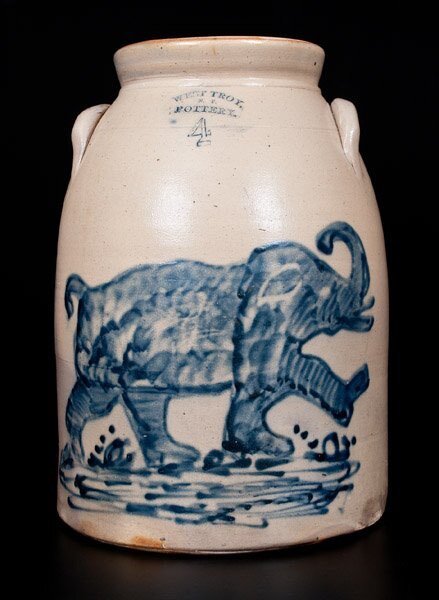Appraisal Story: Evaluating a 'One in a Million'
[vc_row][vc_column][vc_column_text]*This story is based on an appraisal experience of a fellow appraiser. For confidentiality reasons, details of the assignment have been changed. Every so often, I hear a story of an appraisal assignment that makes me scratch my head and think, How would I have handled that? This is one of those stories. Have you ever heard of a stoneware crock? Most people haven’t, unless they love Early American utilitarian objects. Think pickling or fermentation jars. They are made of clay and many times decorated with a cobalt blue number (indicating the size of the vessel), an impressed maker’s name, and then fired. Sometimes, they are decorated with a single simple figure, like a bird or a flower. You can buy a new one at Williams Sonoma for under $100, but older, rare ones can sell for $100s and even $1000s.But, the crock that fellow appraiser, Joe, was charged with appraising was the Holy Grail of stone crocks. It was huge and decorated all over with exotic birds, flowers and fancy writing. His client retained him so that he could meet the IRS’ appraisal requirement for taking a charitable donation tax deduction.Joe began the project by trying to find similar objects. He studied the libraries of museums and the archives of stoneware makers. He consulted with pottery collectors, specialists and dealers. He researched auction sales results of stoneware crocks. Nothing like this crock had ever come to market, nor been seen. The largest vessels he found were less than half the size. The fanciest vessels he found had 75% less decoration. This crock had no comparables. How could Joe assign a value to this unusual crock?
Have you ever heard of a stoneware crock? Most people haven’t, unless they love Early American utilitarian objects. Think pickling or fermentation jars. They are made of clay and many times decorated with a cobalt blue number (indicating the size of the vessel), an impressed maker’s name, and then fired. Sometimes, they are decorated with a single simple figure, like a bird or a flower. You can buy a new one at Williams Sonoma for under $100, but older, rare ones can sell for $100s and even $1000s.But, the crock that fellow appraiser, Joe, was charged with appraising was the Holy Grail of stone crocks. It was huge and decorated all over with exotic birds, flowers and fancy writing. His client retained him so that he could meet the IRS’ appraisal requirement for taking a charitable donation tax deduction.Joe began the project by trying to find similar objects. He studied the libraries of museums and the archives of stoneware makers. He consulted with pottery collectors, specialists and dealers. He researched auction sales results of stoneware crocks. Nothing like this crock had ever come to market, nor been seen. The largest vessels he found were less than half the size. The fanciest vessels he found had 75% less decoration. This crock had no comparables. How could Joe assign a value to this unusual crock? How do you appraise an item when nothing of its kind and quality has ever been seen, let alone sold? Joe spun his wheels for a long time, but eventually came up with a solution: The way to find the value of a One-Of-A-Kind object is to find out how other One-Of-A-Kind objects compare to items within their genre. Joe compared the prices of baseballs signed by famous players with the price of a baseball signed by Babe Ruth on the occasion of his 60th home run. He looked at the prices of vintage dresses & the price of the dress Marylyn Monroe wore when she sang “Happy Birthday, Mr. President” to John F. Kennedy. He analyzed the sales of astronaut uniforms with the one Neal Armstrong wore when he was the first man to walk on the moon.
How do you appraise an item when nothing of its kind and quality has ever been seen, let alone sold? Joe spun his wheels for a long time, but eventually came up with a solution: The way to find the value of a One-Of-A-Kind object is to find out how other One-Of-A-Kind objects compare to items within their genre. Joe compared the prices of baseballs signed by famous players with the price of a baseball signed by Babe Ruth on the occasion of his 60th home run. He looked at the prices of vintage dresses & the price of the dress Marylyn Monroe wore when she sang “Happy Birthday, Mr. President” to John F. Kennedy. He analyzed the sales of astronaut uniforms with the one Neal Armstrong wore when he was the first man to walk on the moon. After drawing the bell curve of each of these genre’s sales, Joe discovered that an outlier object sells for approximately 3 TIMES the price of the highest sale within the genre. Even with no comparables, the IRS accepted his methodology and valuation conclusion.
After drawing the bell curve of each of these genre’s sales, Joe discovered that an outlier object sells for approximately 3 TIMES the price of the highest sale within the genre. Even with no comparables, the IRS accepted his methodology and valuation conclusion.
How would I appraise a One-Of-A-Kind work?
Many times, I have applied the accepted methodology of adding or subtracting the value of individual characteristics like one does with Real Estate – by the square foot, or number of bedrooms. But, I couldn’t help but admire Joe’s ingenuity in coming up with an acceptable value for a truly One-Of-A-Kind work of art.Even though I have been appraising for a long time, it is ALWAYS my pleasure to learn from other appraisers. I have the most interesting job (and the most interesting colleagues)!Hire an appraiser that stays abreast of past and current market data, evolving accepted practices, and creative analysis. For your appraisal needs, contact Lynn Magnusson, AAA, ASA.
Co-Authors: Lynn Magnusson, ASA, AAA and Becky Lipnick, Communications Coordinator[/vc_column_text][/vc_column][/vc_row]